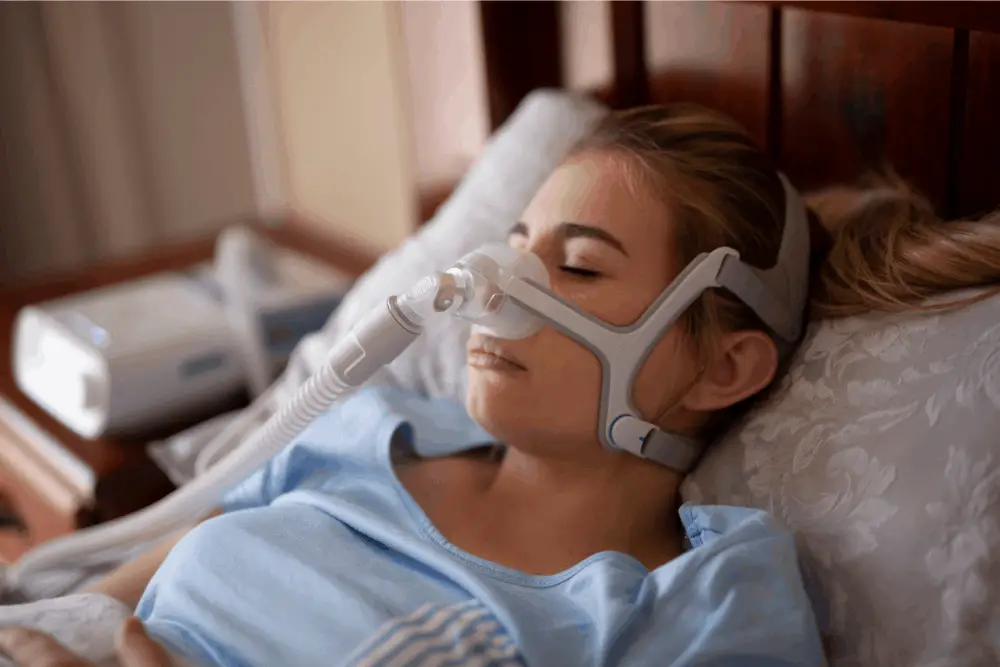This is not a normal side-effect and it is indicative of two issues: either the pressure level on your machine is set too high and needs reducing, or you have blocked sinuses that are obstructing the airflow of the CPAP naturally.
As your sinuses actually wrap around your head and right behind your ears (they’re not just in your nostrils!), if your nose is blocked and you’re using a CPAP, you accidentally create a difference in pressure between your different sinus cavities.
Basically, if you’ve got a cold and you’re waking up with a headache after a night of using your CPAP, then that’s probably why. If not, try turning down the pressure settings on your machine and seeing if that solves the problem.
If you aren’t lucky enough to have a heated CPAP machine with an integrated humidifier, it could be worth investing in one, as these are fantastic for ensuring your sinuses stay wide open throughout your entire sleep, leaving you with no headache.
When you’ve tried all of the above to no avail, it could be worth a visit to your Ear, Nose and Throat specialist, as they will be able to conduct a series of tests to determine what the pain you’re experiencing is caused by.

What does a sleep apnea headache feel like?
Although some may compare a sleep apnea headache to a migraine, there are actually some distinctive differences for most sufferers. For instance, they are usually felt on both sides of your head, whereas a migraine tends to occur on just one.
Likewise, a sleep apnea headache tends to be at its worst when you first wake up and then gradually get better as your sinuses open and you begin to breathe without obstruction, typically fading away completely in around an hour or so.
You’ll also find that a sleep apnea induced headache occurs on a far more regular basis than a migraine, which tends to be less frequent but lasts for hours, if not days when they are experienced.
Other signs that indicate you’re suffering from a migraine and not a sleep apnea related ailment are if you also feel nauseous or vomit, and if you experience blurred vision or sensitivity to light, as these symptoms should not occur from using a CPAP.
In order to determine whether it is the CPAP causing your headaches, it might be worth making a note of when you experience the symptoms and what exactly they are. This will help you present your case if you need to visit a doctor or your ENT.
How do you get rid of a sleep apnea headache?
Other than managing your pain with some ibuprofen or a similar over-the-counter medication, the adjustments you’ll need to make are typically to your CPAP machine, in order to encourage your sinuses to open up fully and stay open.
First things first, you want to make sure you’re cleaning that machine often - this needs to be done at least once a week if not more, to prevent the buildup of any bacteria. Making sure your face is fully clean before you use the CPAP will help too!
You might want to have a look at the mask you’re using and evaluate whether a new mask with cushions in the nasal cavities might be beneficial for you. If you’re not sure if it’s the right style, have a chat with your sleep doctor who will help decide.
Does your machine have heating or a humidifier? No? These may sound like fancy additions that aren’t really necessary, but they can actually make the whole CPAP experience a far more comfortable one, as well as reduce the chance of headaches!
Regularly struggling with blocked sinuses, but still need your CPAP? It could be worth a chat with the sleep specialist again, to see if they can offer you a medication that will clear up the blockages and help your sinuses stay wide open.
If you’ve been prescribed a certain pressure then you ought to stick to it, but if you think it’s causing you pain, it might be work asking for a reassessment. Lifestyle changes like losing weight, gaining weight or quitting smoking can change things.
Likewise, there is also an option for pressure to “ramp” on many CPAPs, which means it starts at low pressure and gradually increases to maximum, rather than starting out on full blast and shocking your poor sinuses into submission.
It’s worth reiterating that you need to consult with a medical professional, preferably your own sleep specialist, before you make any of these changes. The mask, pressure, and CPAP you’ve been assigned will be for a specific reason!
That isn’t to say they can’t be changed - just that your doctor will be able to make sure you do so safely and securely.

Damon Wiseley is a Registered Respiratory Therapist and Certified Pulmonary Function Technologist.
